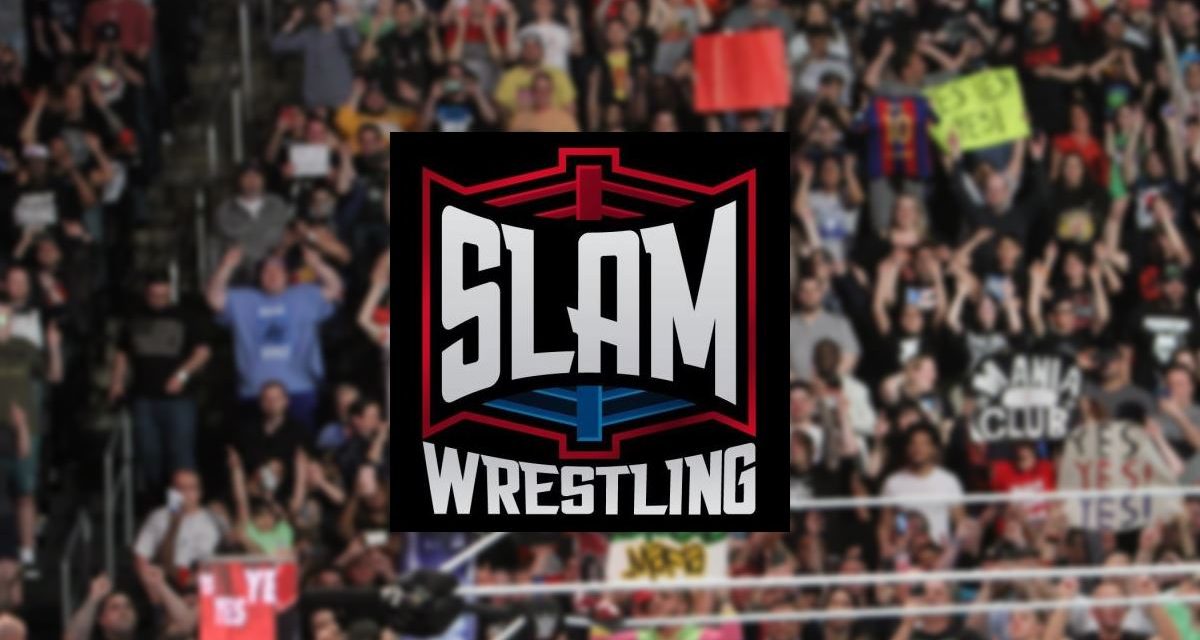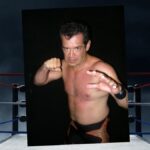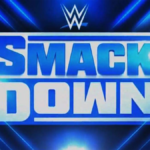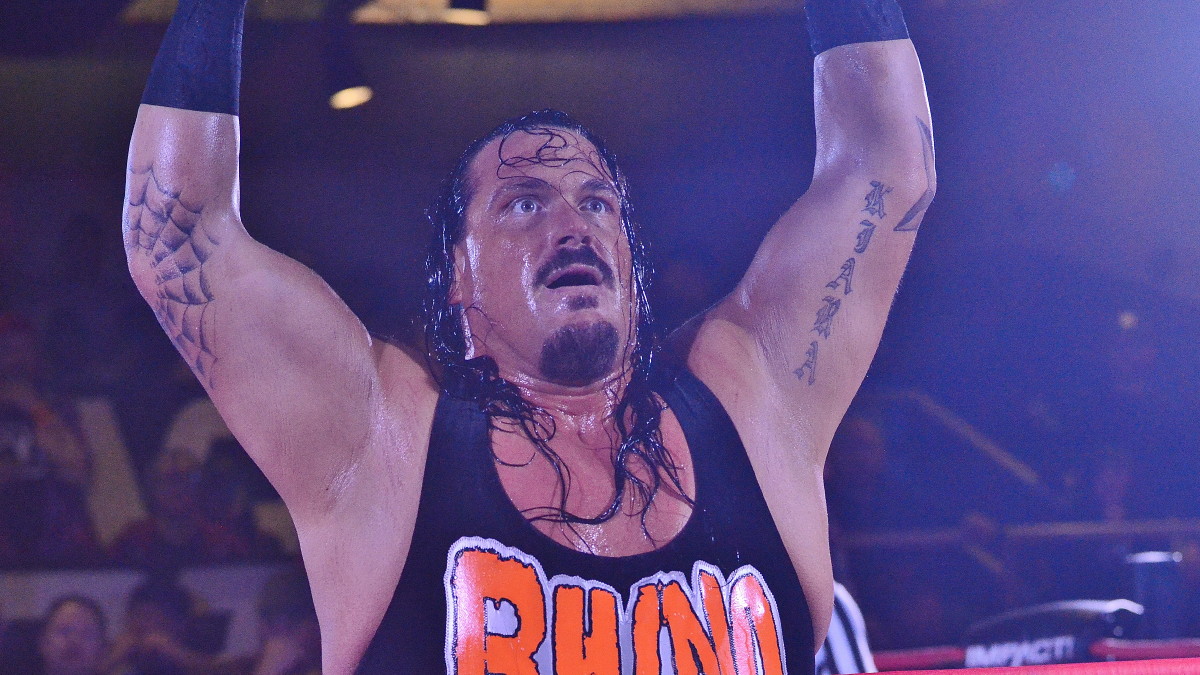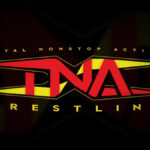By PATRIC LAPRADE and YVES LEROUX
Hardcore wrestling hit a peak in 1999. ECW got a national TV deal with TNN, and the WWE, wanting to capitalize on their little brother’s success, had just created a hardcore title and the TLC matches they had were off the roof. In Montreal, a new wrestling promotion called the IWS was about to start, using the same two things that made ECW so successful: internet and hardcore wrestling. Saturday night, 12 years later, the International Wrestling Syndicate presented its very last show ever.
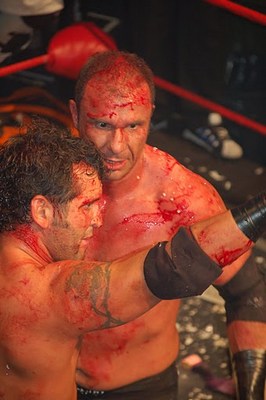
Sexxxy Eddie and PCP Manny hug at the conclusion of the final IWS show. Photo by Karen Broadway
Twelve years is a long time, and SLAM! Wrestling caught up with a number of key people behind the scenes and some of the stars of IWS before and after the rowdy show at Montreal’s famed Club Soda.
“I was a huge tape trader and knew all about ECW and Japan promotions,” said the owner of IWS, Manny Eleftheriou — wrestler PCP Manny. Using his extensive wrestling knowledge and having a partner, Nick Paterson, who was as passionate about the business as he was, Eleftheriou wanted to bring some of the ECW style to Montreal.
“ECW was not well known in Canada, so the things we did, most of our crowd was seeing it for the first time,” he added.
After Paterson, he met with Eddy Dorozowsky, a Dawson College student better known as wrestler Sexxxy Eddy, and the three of them decided to start their own wrestling company.
“We were sitting in a bar named Wally’s Pub looking to find a way to do this. We didn’t have a ring and didn’t have a venue. All of a sudden I looked at four columns in the bar that were exactly 16′ by 16′. I told Eddy and Nick ‘What if we put ropes from column to column and put gym mats in the center of it?’ And this is how the IWS got its start,” said Eleftheriou.
Anthony Tonin, who wrestled under the name of TNT, was on the very first show and was a very important player in the years to come. “I remember the day before the show I wanted to try the ropes, so I started running them and the whole thing just fell apart! Manny told me, ‘No! You can’t run these ropes.’ It was hilarious.”
After a few shows in ’99 and a show in early 2000 at another venue, IWS started running its best venue ever, Laval Scratch, a bar just north of Montreal. “What defined the IWS the most is the atmosphere there was. When you came to an IWS show, you knew just by getting in that this was not a traditional Quebec indy wrestling show. That’s why we were selling way more IWS t-shirts than any wrestler’s t-shirt,” said Eleftheriou, better known as just Manny. “The main reason why IWS was drawing so well at the beginning was because Joey Fitzmaurice, also known as The Green Phantom, was the king of Two-Mountains, a small town just outside of Montreal. If it wasn’t for Joey, we’d have had 25 to 30% less fans,” said Tonin.
Paterson agreed with Eleftheriou. “If I’d have to finger point the success of the early version of IWS, I’d say it was due to Joey Fitzmaurice who had so many contacts and was bringing a lot of people.”
The promotion started making a name for itself with its hardcore wrestling, crazy balcony dives, naked girls, fluorescent tubes and thumbtacks. But something else was in their favour.
“We were the only English wrestling promotion in Quebec,” remembered Manny. The promotion, being owned then by both Manny and Wild Rose Production, an adult-film company, were bringing something totally different to the game in Montreal and, like ECW a few years before, IWS was developing a cult following. “Wild Rose was important in the sense that they could do things we couldn’t, especially internet-wise,” said Eleftheriou.
“Storylines could be followed through a medium that had, up to that point, not been exploited by any promotion: the internet,” said long-time Quebec wrestling booker Patrick Lono, who saw the IWS right from its start.
“The concept of a wrestling promotion segmenting the market by serving only a mature English-speaking audience made a lot of purists, me included, believe it would never work,” admitted Lono. “What we didn’t take into account was the concept of the dangling carrot. In other words, by telling the younger internet-savvy demographic that they couldn’t attend shows, it made them want it even more. At the time, did they have the best promo men? No, but they were the only ones speaking Shakespeare rather than Molière. Did they have the best in- ring workers? Far from it. So what was the appeal of the IWS? The same thing that we all thought would be its downfall: market segmentation. We quickly found out that there was a group of fans who understood English (after all that had been the language of televised pro wrestling in this territory for the last 12 years), wanted to get drunk, listen to loud music and swear at wrestlers without fear of reprisal. Not only could they now do so, but such outlandish behaviour was encouraged.”
If ECW had Hat Guy and his buddies, the IWS had from the very beginning its hardcore soldiers. But something was missing: good solid wrestling matches. Up until 2003, the IWS was known more for its crazy bumps and adult-oriented shows than good ol’ rasslin. “I was telling them they needed to mix hardcore and wrestling if they wanted to expand,” said Tonin.
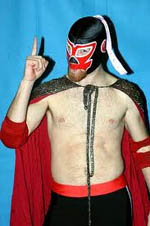
El Generico.
So like ECW did when it brought cruiserweights and lucha libre, IWS brought wrestling to its shows. The likes of former Jacques Rougeau students Beef Wellington, Kid Kamikaze and Kevin Steen all started. Add to this the debuting El Generico and Pierre-Carl Ouellet, whose IWS debut marked the first time he was wrestling regularly for a promotion since his departure from the WWE.
“We like to say we were the first to bring wrestling into IWS,” said Wellington.
“These guys synched with the roster so well,” added Fitzmaurice.
“Much like Metallica fans had done eight years prior, some IWS fans rebelled at this more socially acceptable approach to pro wrestling, preferring the anti-establishment style used in the past,” explained Lono. But in the end, it was way more profitable for IWS than not, because it was able to reach a bigger wrestling audience.
While there was now more wrestling in the IWS, the promotion got a lucky break from the language cops in Laval.
“They came to our venue and told us that our posters were not respecting the laws, because the headlines weren’t 70% French and 30% English. So it gave me the idea of creating a stable that would only speak French,” remembered Eleftheriou.
“The SLI (Syndicat de Lutte Internet, the exact French translation of the IWS), was the greatest thing,” said Michael Ryan, long-time IWS publicist. Much like WWE did with Right to Censor or ECW did with The Network, it used a real life story that worked perfectly in its shows.
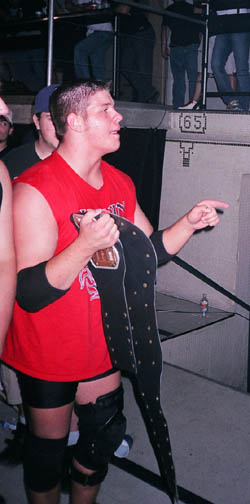
A young Kevin Steen at an IWS show in June 2004. Photo by Greg Oliver.
From all those newcomers, Steen and El Generico really stood out from the group, on their way to becoming well-known international wrestlers. “I’m so proud of what Steen and Generico became,” said Eleftheriou, “but a bit more for Generico since it’s a gimmick we started from scratch. On the other hand, I always knew Steen was going to be great.”
Tonin also remembers the debut of El Generico. “I needed to wrestle someone and thought this kid would be great. Manny wasn’t too thrilled about it because he said he looked like a child. So we put a mask on him. Manny wanted me to squash him, but I had nothing to gain doing this so I beat him up good, but got disqualified giving Generico his first win and the crowd loved it. Looking back, it was the best decision ever!”
“The single event that really put us on the map internationally was Sexxxy Eddy, at CZW’s Tournament of Death in 2004 in Delaware, drinking his own blood in a freaky way after he got busted open on his arm. That match made CZW want to book Eddy again and they asked me to send three other of our wrestlers,” remembered Ryan, who was also involved in booking at some point. “I sent Steen, Generico and Exess, who, with Eddy, worked in a 4-Way that was dubbed match of the year for CZW.”
That match was the stepping stone for Steen and Generico’s international success that saw them main event many Ring of Honor shows since. “We didn’t make them, but we gave them a place to shine,” said Eleftheriou.
This is exactly how Kevin Steen himself sees things. “The IWS gave me my start. It opened the door for me to go wrestle in the United States originally which is what helped my career get to the next level. It was a huge part of my career, definitely.”
Other big names make the trek to Montreal over the years.
Eleftheriou recalled what he thought was one of the biggest moments ever. “I will also always remember having Sabu here on the Saturday and seeing him on the following Monday at WWE RAW. We were the last indy promotion he worked prior to the new ECW angle they were doing. To this day, it was our biggest crowd. Running the ECW Arena was also special. Having guys like the Dudleys, Kevin Nash and being able to sign Pierre-Carl Ouellet are all things I’m proud of. Man, there so many!”
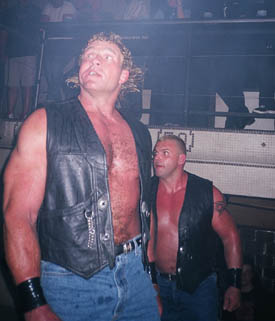
Sid Vicious returns to wrestling in June 2004, as a partner to Pierre-Carl Ouellet. Photo by Greg Oliver.
Some of the other notables included Christian Cage, when he was the NWA-TNA champion, the Briscoe Brothers, Joey Mercury, and it is hard too forget the first in-ring return of Sid Vicious after his injury in WCW. “This was probably our biggest moment,” said Ryan.
For their very last show, IWS decided to go with no outside stars, but focusing on the guys that sacrificed so much for the promotion for several years.
The results:
- The 2.0 win over the Super Smash Bros set the tone for the evening as it was one of the best matches on the Quebec indy scene this year.
- Up next was a comedic match with Fred “la Merveille” against Beef Wellington that included ladders and laminated movie posters (Paul Blart: Mall Cop, for those who need to know) being demolished. After a lengthy match, Fred took the pin only to have the Hardcore Ninjaz enter the ring and annihilate him.
- Twiggy got the win against “MVP” Michael Von Payton, who refused to show good sportsmanship and shake hands with Twiggy.
- Montreal native Lionel Knight got a three count against Christopher Bishop.
- After a two-year absence, Max Boyer won the Canadian championship belt from Shayne Hawk in a six-way elimination match that saw Vanessa Kraven, Alex Silva, Kid Kamikaze and Mike Bailey get eliminated in that order. While Boyer was celebrating in the ring, Franky the Mobster showed up to interrupt the cheering. His match against Pierre-Carl Ouelett had been cancelled as PCO couldn’t make it to the card. Franky wanted to find out who he was going to wrestle, and Boyer was more than happy to put his newly-acquired belt on the line in an unannounced battle against Franky. A very hard fought battle that saw Boyer retains his title.
- For the grand finale of the evening, it was the seventh and final “Fans bring the Weapons” match, which has been a signature and unique occasional event for the IWS. These matches have been some of the most gruesome hardcore extreme matches just about anywhere in the world of wrestling, and last night was no exception. Fans were encouraged to bring any type of “legal” weapons for the wrestlers to use. “If we were not the first ones to do that kind of match, we are without a doubt the ones that popularized it,” said Ryan. The IWS champion, the Green Phantom, was putting up his belt against PCP F’N Crazy Manny (the boss, Eleftheriou), hardcore specialist Arsenal and the “Sex Express” Sexxxy Eddy. It was an extremely messy and spirited match, in which anything went and could be used such as computer keyboard, wooden skewers (about 10 became part of Eddy’s cranium), sex toys with thumbtacks attached to the end, a Guitar Hero guitar, and many, many fluorescent tubes. Sexxy Eddy even went upstairs on the balcony to dive onto a crowd of fans with the other wrestlers mixed in. The 500 fans in attendance roared their approval. The Green Phantom managed to retain his belt with a win, but then took the mike and told the crowd that since no one will ever battle for it anymore, Manny should leave with the belt, which was met by a thunderous wild cheer from the crowd.
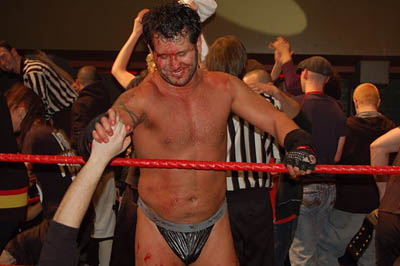
Sexxxy Eddy greets the fans after the final IWS show. Photo by Karen Broadway.
Now that it is over, what’s the feeling of those who had to play such a huge part in the company’s success?
“The IWS was very important for Quebec wrestling because in the years IWS was good, the other promotions were not. They were known as the rebels but became the best for a solid four to five years,” said Tonin.
“There’s a time for everything,” said Wellington simply.
“It saddens me because that’s where a lot of people became stars. It’s where Quebec hardcore wrestling became known around the globe, where some of us travelled from to end up at CZW, IWA and other places,” said female wrestler LuFisto, who performed in IWS when she was known as “The First Lady of Hardcore.” “Manny can be proud of what he accomplished. IWS was awesome.”
“If you wanted to be booked outside the country, you had to go to IWS,” said Matthew Lee, better known as Shane Matthews.
“The IWS taught me how to wrestle. They gave me a chance to perform in front of huge crowds. Without them, I would have not wrestled in Europe or CHIKARA. I’m going to miss having fun, I’m going to miss that special feeling I had coming to an IWS show,” said James McGee, who works as Twiggy, and wound up the very last booker of the promotion.
“I will miss the guys, the organization and the very special fans, they were unique and the most vocal anywhere,” said Sexxxy Eddy after the show.
Long-time referee Bakais was very emotional too after the night: “This feels like it isn’t happening, this is surreal.”
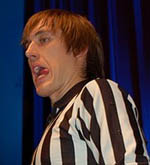
Referee Bakais. Photo by Karen Broadway.
Off the record, one of original said it might not actually be over. “Wrestling is like Star Trek in a sense that nobody ever dies as a character. I have the feeling it’s not over,” the secretive voice said.
But for Manny Eleftheriou, it’s very clear. “This is the last show; we won’t be doing any other show, not even a reunion in a few years.”
“In a sense, since we ran so few shows in the past year and a half, this is like almost a reunion show,” said Lee.
How to sum up more than 10 years of pure madness, wrecking stunts, excellent wrestling, great storylines and a “few” fluorescent tubes, thumbtacks or tables on fire?
“It was not every week or every two weeks, it was only once a month, so people felt it was like a happening, a place where you could have a beer and have fun. The IWS made the fans feel so special, like if they were part of the show,” said Lee.
“IWS was violence, wrestling, comedy, it was everything. I’m glad and sad. It’s hard work you know, I have a lot of mixed feelings right now,” said Fitzmaurice.
It is really the end of an era for Quebec indy wrestling. The IWS was without a doubt the Quebec wrestling promotion of the last decade and brought to the wrestling fans so many great moments.
Manny Eleftheriou, a man who put his money, his heart and his soul on the table so many times for the IWS, gets the last word. After all was said and done, after the very last “Fans bring the Weapons” match in the history of the IWS, a bloodied Manny took the mike and spoke to his hardcore soldiers one last time interrupting them from chanting “I-W-S” in unison. “This is exactly why we did this for 12 years. Thank you!”
